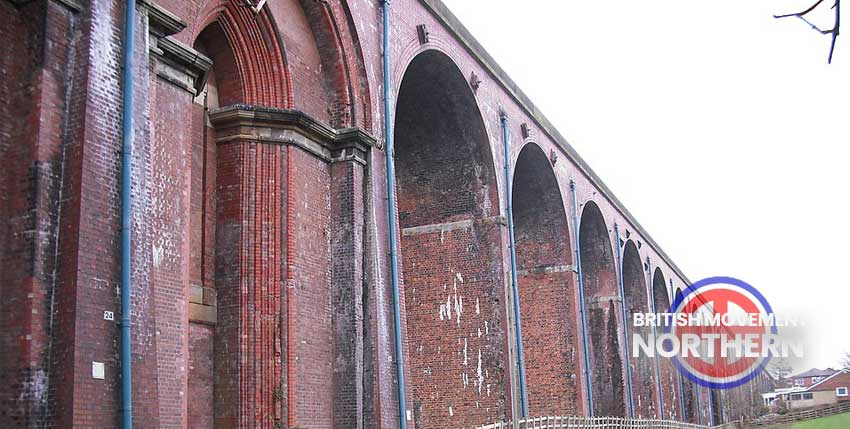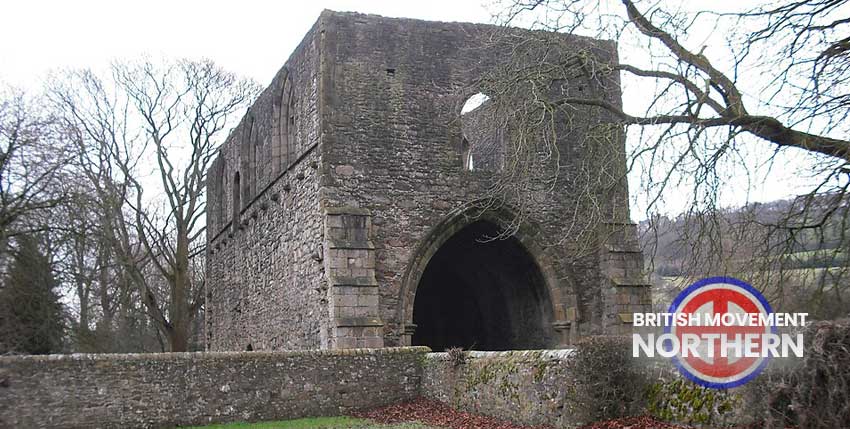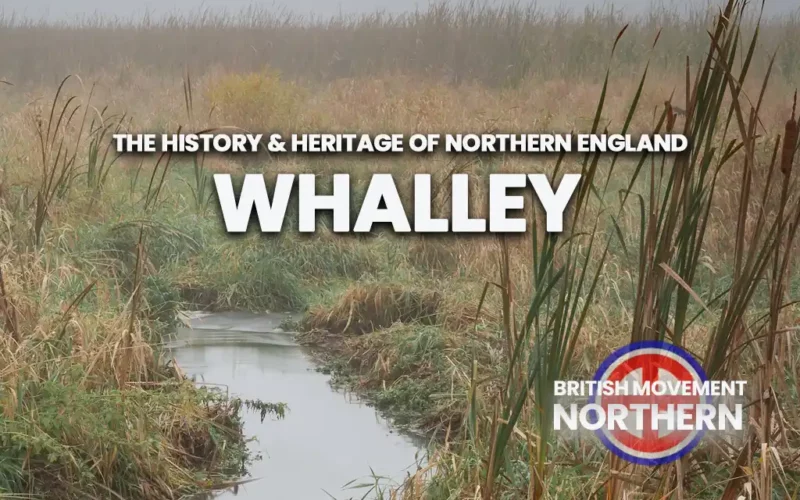Once again this series casts its gaze upon a small town that did not reach any historic significance until the Norman period in the decades after the Norman invasion of 1066. The North of England had taken longer to pacify and bring under control than the south-eastern and midland areas of England.
In the historic records the settlement has been referred to as; ‘Wallebi’ also ‘Wallega’ or ‘Walelga’. The Anglo-Saxon Chronicles record the settlement as Hwaelleage, or Hwaellaege. In the Middle Ages as ‘Wallelga’, later as ‘Walleye’, ‘Qwalley’ and later as ‘Walley’ or ‘Wallay’ and ‘Whallay’.
Some language experts believe that the original name for Whalley was derived from the Celtic word “Whallis” which means ‘water’ and was possibly a reference to the settlements position in relation to the River Calder and the River Ribble. The Celtic language of the Britons continued long into the Anglo-Saxon era.
Whalley is a small town, some sources say township, others say it is only a village, that sits in the Ribble Valley of Lancashire, flanked by the River Calder. The town has a long history and, by a strange stroke of history, was once classed as being mostly in Lancashire, but partly in the West Riding of Yorkshire.
In medieval records, Whalley was classed as being within the “hundred of Blackburn”, but also fell within the “wapentake of Staincliffe and Ewcross, West Riding of Yorkshire.” Whalley Nab is the prominent local landmark and is the wooded hill overlooking Whalley.
On the edge of Whalley is Portfield hillfort, which has been dated to the late Bronze Age or the early Iron Age and overlooks the valley of the River Calder, it is the oldest settlement close to what today is the town of Whalley. The hillfort is sometimes referred to as Planes Wood Camp.
In the Iron Age, as with most parts of the North, the settlement stands in territory once controlled by the Celtic tribe, the Brigantes, although the village on the site of the modern town came centuries later. There is little information regarding Whalley during the period of Roman Britain, but the site of the settlement was probably established during the early Anglo-Saxon period and fell under the control of the Anglian kingdom of Bernicia, later becoming part of the kingdom of Northumbria. The first mention of Whalley as a settlement is in the Anglo-Saxon Chronicles for the year 664.
St Mary and All Saints Parish Church in Whalley was first established in the year 628, and is reputed to be a location where the Anglo-Saxon saint, Saint Paulinus preached to those local peoples who were converted to Christianity. The current stone-built church is in the Norman style and replaced the earlier timber built Anglo-Saxon church in the 13th Century.

The church grounds of St Mary and All Saints Parish church has several Anglo-Saxon stone crosses from the earlier period one dated to 628 and others probably from the 10th Century. The church had a tower added in the 15th Century and further later additions in 1844. Whalley features in the Domesday Book from 1088, where the name of the town is spelt “Wallei”.
Whalley Abbey was founded in 1296 by Henry Lacy, Earl of Lincoln, and was a Cistercian abbey with an attached monastery. Although only classed as a village at the time, Whalley earned the reputation of being the “ecclesiastical capital of east Lancashire.”
In 1537 one of the monks, named William Haydock, was executed in a field known as “Little Imps” for his part in the revolt known as the Pilgrimage of Grace. Also arrested and executed for his part in the Pilgrimage of Grace was the abbot, Abbot Paslew who was executed for high treason.
As with many such monastic communities, it suffered in Henry VIII’s Dissolution of the Monasteries, at Whalley the demolitions began in 1536. Ownership of its lands and buildings passed to local aristocrats and wealthier landowners.
When the Church of England took control, up to 1858 the parish of Whalley fell under the control of the Archdeaconry of Chester, in the Diocese of Chester, even though the village was within the county of Lancashire. Spring Wood is an area of Whalley designated as ancient woodland, which lies within the old boundaries of the old monastery and has trees that date back to the 16th century and possibly earlier.
During the English Civil War, there were two military engagements in the area of Whalley. On April 19th 1643, a Royalist force commanded by the Earl of Derby was defeated by Parliamentary forces as it marched towards Padiham. Trapped in a surprise ambush, the Earl of Derby withdrew his troops to Whalley until they were forced back across the River Calder by superior numbers.
The Industrial Revolution certainly had an impact on Whalley, not only was the road network improved but in 1846 the railways began to extend towards Whalley. The ‘Whalley Arches’ are a significant testimony to the industrial heritage of the town. The ‘Whalley Arches’ are an impressive 48 arch viaduct, the longest in Lancashire, which carries the railway over the River Calder.
The ‘Arches’ count as a Grade II listed structure. Built between 1846 and 1850, a significant feat of civil engineering in its time, but not without difficulties during construction, in October 1849 two of the then 41 arches collapsed killing three workmen. The viaduct took three years to build and the line became operational and the railway station in Whalley was formally opened in June 1850.

During the First World War, a large military hospital was established on the outskirts of Whalley and was opened to take casualties from the Western Front in 1915. The hospital had originally been commissioned and planned in 1904 as the Sixth Lancashire County Asylum for the mentally ill, but the War changed those demands for a military medical facility. It was re-designated as Queen Mary’s Military Hospital and between 1915 and June 1920 treated 56,800 allied wounded.
Such was the demand for its services that a special railway line was built to carry wounded servicemen to the hospital, which had its own sidings and platforms, it is recorded that after the Somme Offensive in July 1916 as many as 18 ambulance trains travelled up to the hospital from the south coast.
There is a Commonwealth War Graves cemetery between the hospital site and Whalley. In June 1921 the buildings were re-opened as Calderstones Hospital for the Lancashire Asylums Board. In the post war period the former military hospital became a regional mental hospital, Calderstones is now under the control of the Mersey Care NHS Foundation Trust.

In recent times, Whalley has become something of a focus for tourists, and unfortunately has attracted a burst of bad headlines in the Summer of 2024 as being a place for ‘beer trails’, ‘hen parties’ and ‘stag parties’. The attraction being the town’s so-called night time economy and the 30 licenced premises in the town, pubs, bars and restaurants.
The regional mainstream news media, including the Lancashire Telegraph, seized on the story and made Whalley sound more like central Amsterdam on a stag weekend than the popular tourist township usually promoted by organisations like Visit Lancashire; “Residents of a picturesque village are up in arms as they say rowdy revellers are bringing chaos to their streets. Locals living in Whalley, in Lancashire’s Ribble Valley, have reported property damage, streets littered with vomit, public urination and sex acts, as partygoers come from as far as Preston, Blackpool and Manchester.
“The historic village, known for its 728-year-old Cistercian Abbey, is experiencing what residents describe as ‘Blackpool-isation’, and fear it is becoming a ‘Wild West’ during weekends. Loud music reportedly vibrates through homes into the early hours, with one male resident alleging he was assaulted by a group of women carrying inflatable penises on a hen do.”
Shocking stuff indeed! The handful of locals who were interviewed by the journalists added more salacious details to the story but in the end, after the journalists had lost interest, Whalley returned to business as usual, apart from the usual vague statements from Lancashire Police about increased presence and enforcement. None the less, Whalley remains a popular small town with historic links.
Whalley is fortunate to be relatively unaffected in a region of Northern England where non-white immigration has had a negative impact. The population figures show that the town is 96.3% White, a clear recommendation.
CREDITS
First Image: The ancient parish church of St. Mary and All Saints at Whalley in Lancashire. Craigthornber, CC BY-SA 3.0, via Wikimedia Commons.
Video: With acknowledgements to Visit Ribble Valley.
Second Image: Whalley Arches, east side, from the road. Martinevans123, public domain, via Wikimedia Commons.
Bottom Image: Whalley Gateway from the west. Martinevans123, Public domain, via Wikimedia Common.
The British Movement welcomes articles for possible inclusion on this site from members and supporters across the North of England. Please remember that we have to operate within the laws of this country; we will not include any content that is against the current laws of the United Kingdom. News reports should be topical and be relevant to the regions covered by this website.












